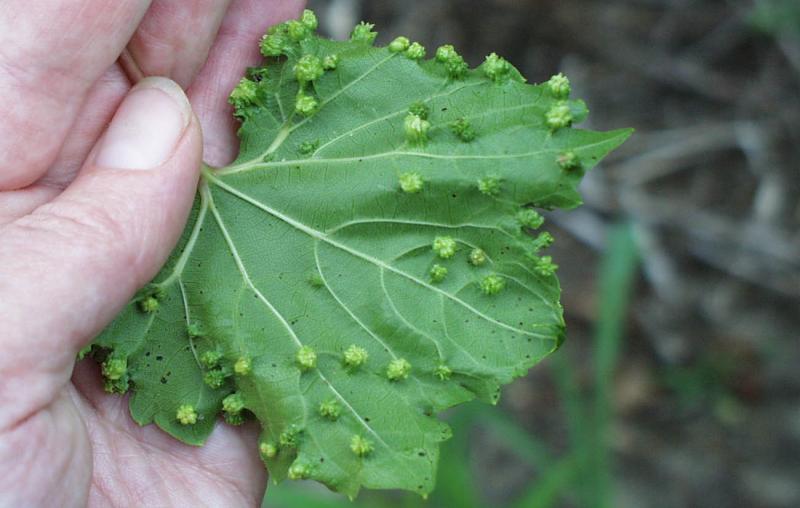Pest Profile

Written by Rhoda Burrows, former Professor & SDSU Extension Horticulture Specialist.
This is the time of year when some grape growers may notice that some of their shoots have bumpy growths on the bottom of the new leaves (Figure 1). These bumps are galls caused by the grape phylloxera, an aphid-like insect with the rather intimidating name of Daktulosphaira vitifoliae, that once endangered the grape industry in Europe. The good news is that the roots of our northern grape varieties are not susceptible to these insects, so their damage is restricted to the leaves.

Furthermore, even the leaf damage, while unsightly, generally comes late enough in the vine growth cycle to have little effect on grape yield or overall vine health. If you see the first galls late in June or early July when there are already 12-16 leaves on each shoot (Figure 2), then the galls will make the shoot tips ugly, but not affect yield or long-term growth, thus control will not be needed.
Lifecycle & Behavior
In rare cases, infection is early and severe enough to compromise the vine’s ability to produce enough leaf surface to support the vine. To understand how to manage this insect, one must understand its life cycle. Our form of phylloxera survives the winter as a fertilized egg under the bark of the grapevine. A single female hatches from each egg about the time the new shoots have produced 5 expanded leaves, and migrates to a young leaf where she causes a gall to form around her, and after about 15 days, is mature enough to lay 100-300 eggs within the gall before dying. Around bloom time (or at the 10th leaf stage), the eggs hatch into asexual wingless forms, called crawlers. These yellow aphid-like crawlers emerge from the gall and crawl onto the new leaves at shoot tips, where they settle into the upper surface of the immature leaves. Infestation of infected leaves will first show up as a rash-like appearance on the lower leaf surfaces. Their sucking causes more galls to form on the under surface of the leaves, which they then fill with eggs. There can be three to five generations of foliar phylloxera per season in eastern North America (it is not known how many generations can occur in the upper Great Plains).
Management Considerations
Different varieties may have different susceptibility: Frontenac is highly susceptible, La Crescent and Marquette somewhat less so. While there are some natural predators which feed upon the foliar form of grape phylloxera, none of these provide adequate control of the pest.
Currently there is only one insecticide registered that can penetrate leaf galls (a product called Movento, which is not available to homeowners), so control must focus on preventing the crawlers from reaching and attaching themselves to the leaf surfaces. A number of insecticides are labeled for the foliar form of grape phylloxera in South Dakota, but they will vary in effectiveness, and should be used only when the presence of phylloxera has been confirmed (look for the initial galls on the three oldest leaves). Most are contact sprays, which will not control the phylloxera once they are inside galls, so they need to be applied starting when the shoots have 5 to 10 leaves. Products with some residual action will be most effective. One of the most effective repellent products available for homeowners or small-scale applications is “Surround”, a product containing kaolin clay that is also approved for use in certified organic vineyards. It must be reapplied after rainfall, and repeated as long as new leaves appear, until there are 10-12 leaves per shoot. Late season treatment (once shoots have more than 12 leaves) of grape phylloxera is not effective and is a waste of time and money.


